Comprehensive Health Promotion Campaign: Obesity, Prevention
VerifiedAdded on 2023/06/04
|12
|4598
|404
Report
AI Summary
This report provides a comprehensive overview of a health promotion campaign designed to address the issue of obesity. It begins by identifying obesity as a significant global health problem, describing its causes, symptoms, and associated physical and psychological risks. The report then details the design, planning, and delivery of a health promotion campaign, emphasizing the importance of data analysis, target audience identification, and the use of effective communication tools. The campaign, named 'Eat healthy, say no to obesity,' aims to raise awareness about the negative impacts of unhealthy eating habits and physical inactivity. Finally, the report discusses the evaluation of the campaign's outcomes, highlighting the need for ongoing monitoring and adjustments to ensure its effectiveness in promoting healthy lifestyles and reducing obesity rates. Desklib provides similar solved assignments and past papers for students.
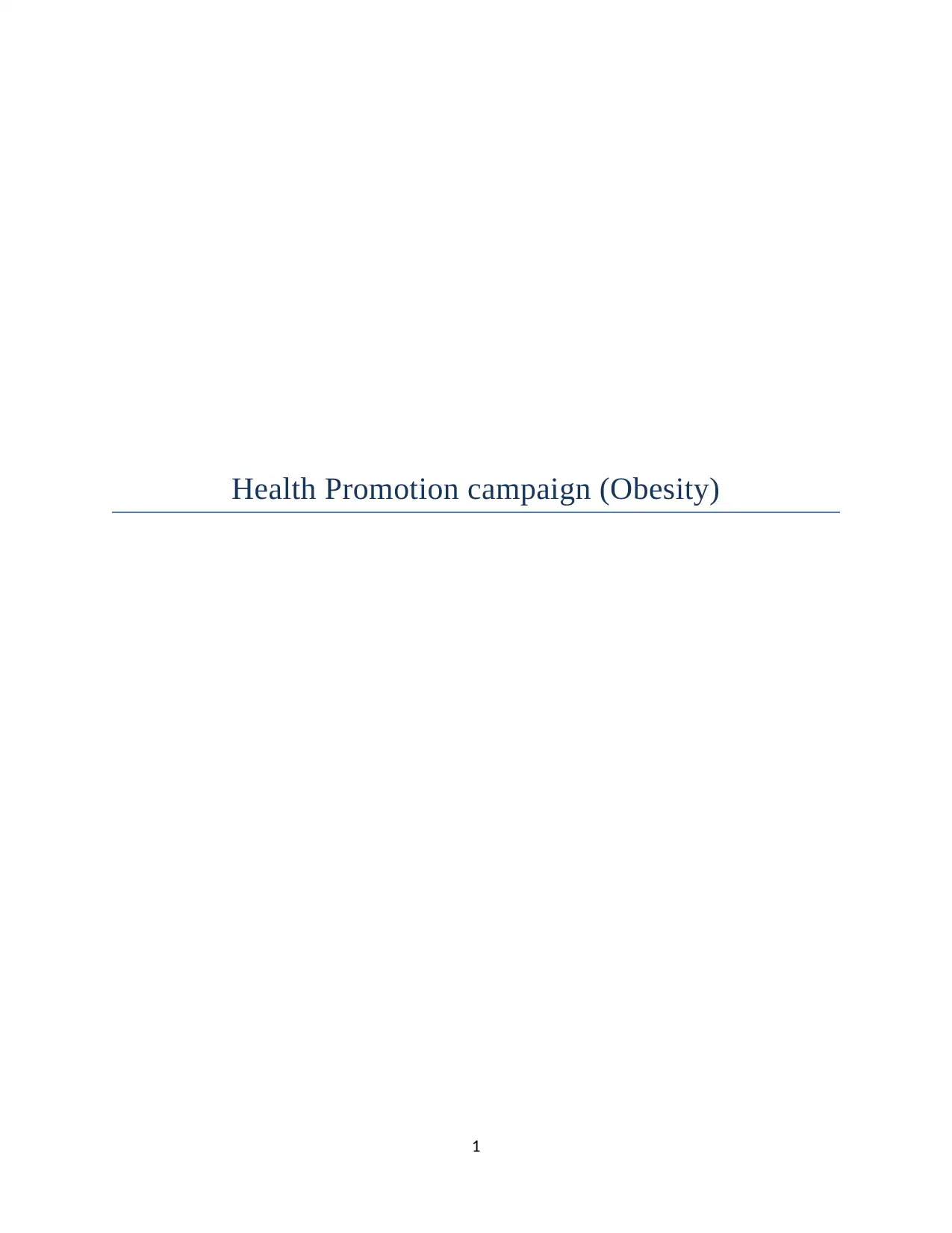
Health Promotion campaign (Obesity)
1
1
Paraphrase This Document
Need a fresh take? Get an instant paraphrase of this document with our AI Paraphraser
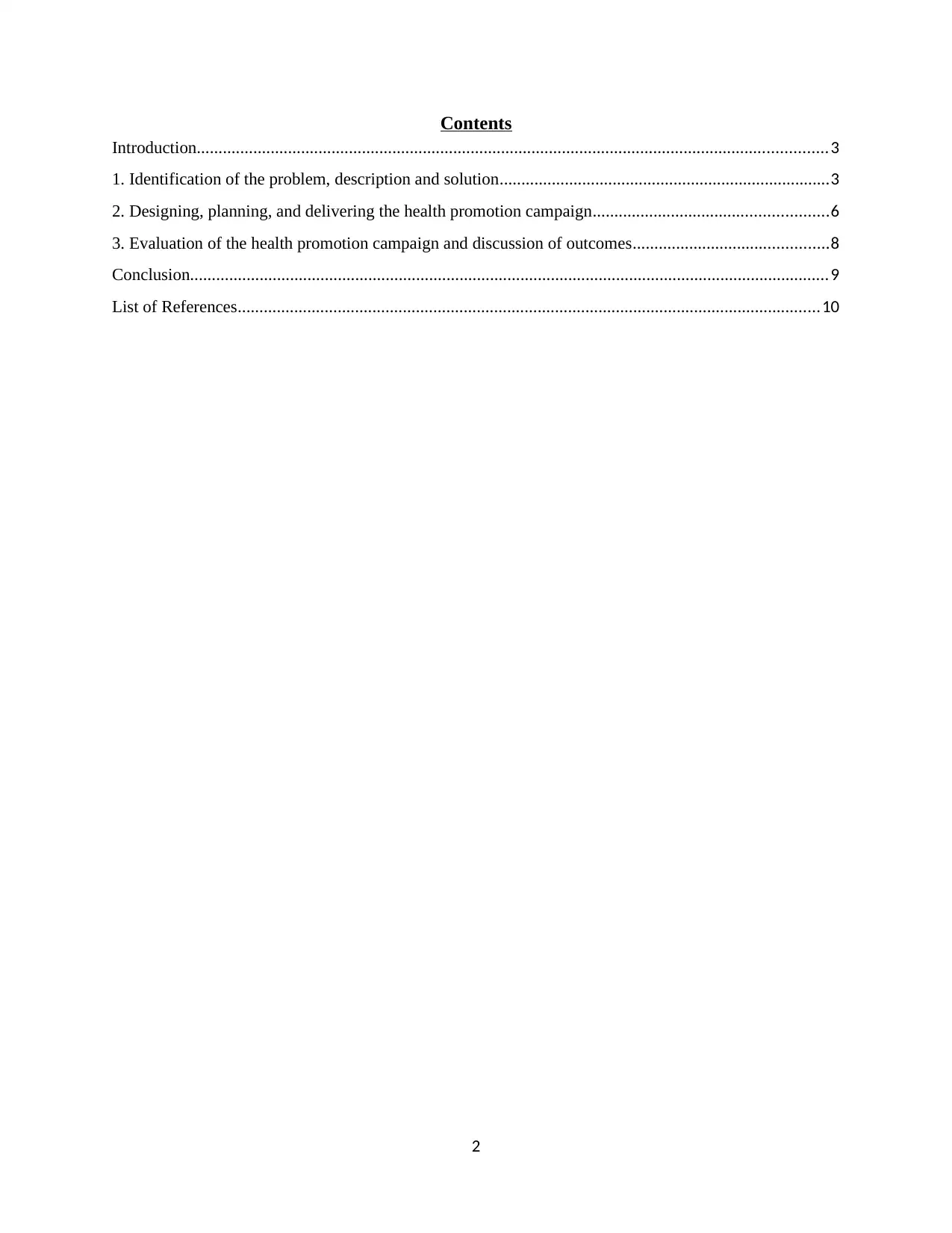
Contents
Introduction.................................................................................................................................................3
1. Identification of the problem, description and solution............................................................................3
2. Designing, planning, and delivering the health promotion campaign......................................................6
3. Evaluation of the health promotion campaign and discussion of outcomes.............................................8
Conclusion...................................................................................................................................................9
List of References......................................................................................................................................10
2
Introduction.................................................................................................................................................3
1. Identification of the problem, description and solution............................................................................3
2. Designing, planning, and delivering the health promotion campaign......................................................6
3. Evaluation of the health promotion campaign and discussion of outcomes.............................................8
Conclusion...................................................................................................................................................9
List of References......................................................................................................................................10
2
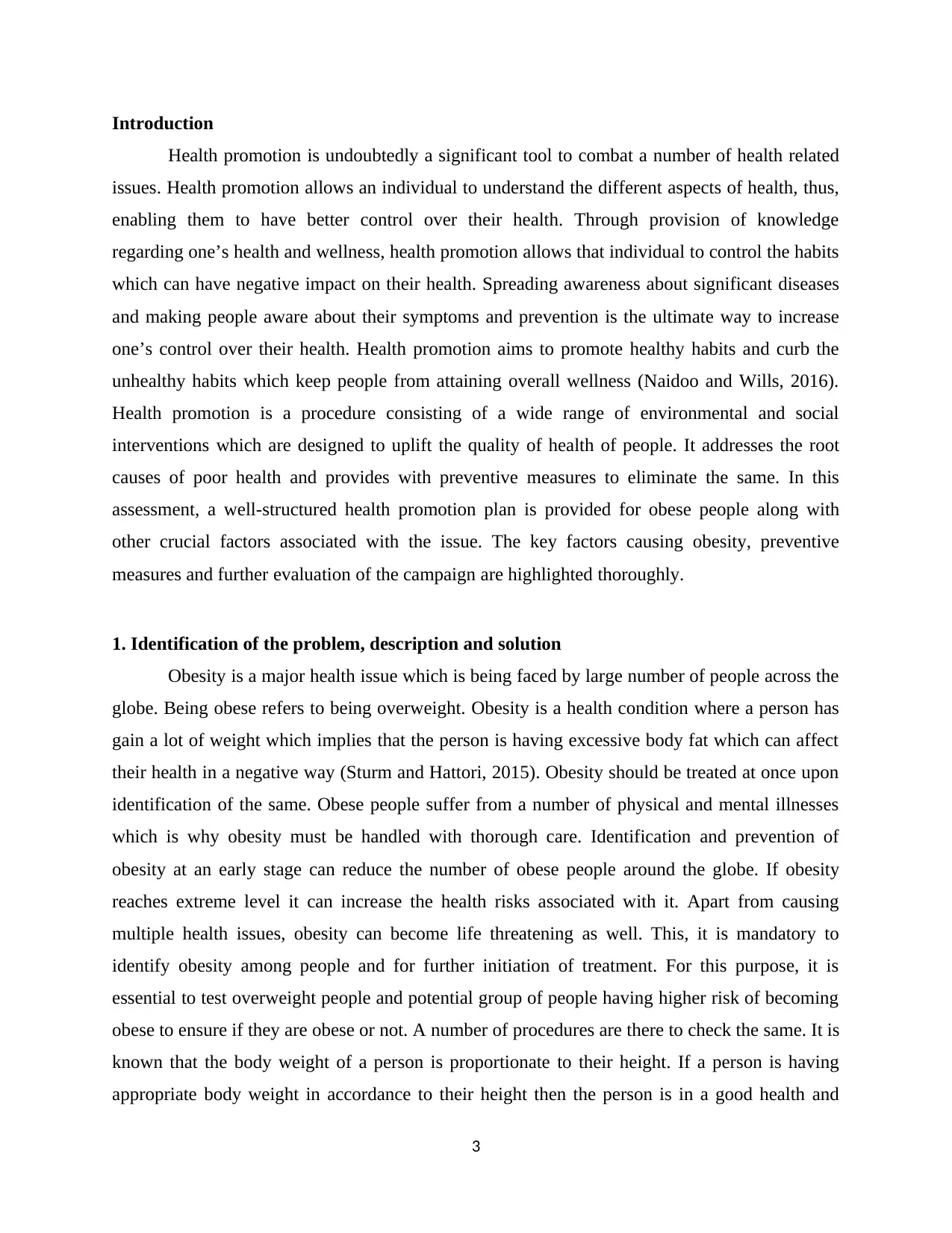
Introduction
Health promotion is undoubtedly a significant tool to combat a number of health related
issues. Health promotion allows an individual to understand the different aspects of health, thus,
enabling them to have better control over their health. Through provision of knowledge
regarding one’s health and wellness, health promotion allows that individual to control the habits
which can have negative impact on their health. Spreading awareness about significant diseases
and making people aware about their symptoms and prevention is the ultimate way to increase
one’s control over their health. Health promotion aims to promote healthy habits and curb the
unhealthy habits which keep people from attaining overall wellness (Naidoo and Wills, 2016).
Health promotion is a procedure consisting of a wide range of environmental and social
interventions which are designed to uplift the quality of health of people. It addresses the root
causes of poor health and provides with preventive measures to eliminate the same. In this
assessment, a well-structured health promotion plan is provided for obese people along with
other crucial factors associated with the issue. The key factors causing obesity, preventive
measures and further evaluation of the campaign are highlighted thoroughly.
1. Identification of the problem, description and solution
Obesity is a major health issue which is being faced by large number of people across the
globe. Being obese refers to being overweight. Obesity is a health condition where a person has
gain a lot of weight which implies that the person is having excessive body fat which can affect
their health in a negative way (Sturm and Hattori, 2015). Obesity should be treated at once upon
identification of the same. Obese people suffer from a number of physical and mental illnesses
which is why obesity must be handled with thorough care. Identification and prevention of
obesity at an early stage can reduce the number of obese people around the globe. If obesity
reaches extreme level it can increase the health risks associated with it. Apart from causing
multiple health issues, obesity can become life threatening as well. This, it is mandatory to
identify obesity among people and for further initiation of treatment. For this purpose, it is
essential to test overweight people and potential group of people having higher risk of becoming
obese to ensure if they are obese or not. A number of procedures are there to check the same. It is
known that the body weight of a person is proportionate to their height. If a person is having
appropriate body weight in accordance to their height then the person is in a good health and
3
Health promotion is undoubtedly a significant tool to combat a number of health related
issues. Health promotion allows an individual to understand the different aspects of health, thus,
enabling them to have better control over their health. Through provision of knowledge
regarding one’s health and wellness, health promotion allows that individual to control the habits
which can have negative impact on their health. Spreading awareness about significant diseases
and making people aware about their symptoms and prevention is the ultimate way to increase
one’s control over their health. Health promotion aims to promote healthy habits and curb the
unhealthy habits which keep people from attaining overall wellness (Naidoo and Wills, 2016).
Health promotion is a procedure consisting of a wide range of environmental and social
interventions which are designed to uplift the quality of health of people. It addresses the root
causes of poor health and provides with preventive measures to eliminate the same. In this
assessment, a well-structured health promotion plan is provided for obese people along with
other crucial factors associated with the issue. The key factors causing obesity, preventive
measures and further evaluation of the campaign are highlighted thoroughly.
1. Identification of the problem, description and solution
Obesity is a major health issue which is being faced by large number of people across the
globe. Being obese refers to being overweight. Obesity is a health condition where a person has
gain a lot of weight which implies that the person is having excessive body fat which can affect
their health in a negative way (Sturm and Hattori, 2015). Obesity should be treated at once upon
identification of the same. Obese people suffer from a number of physical and mental illnesses
which is why obesity must be handled with thorough care. Identification and prevention of
obesity at an early stage can reduce the number of obese people around the globe. If obesity
reaches extreme level it can increase the health risks associated with it. Apart from causing
multiple health issues, obesity can become life threatening as well. This, it is mandatory to
identify obesity among people and for further initiation of treatment. For this purpose, it is
essential to test overweight people and potential group of people having higher risk of becoming
obese to ensure if they are obese or not. A number of procedures are there to check the same. It is
known that the body weight of a person is proportionate to their height. If a person is having
appropriate body weight in accordance to their height then the person is in a good health and
3
⊘ This is a preview!⊘
Do you want full access?
Subscribe today to unlock all pages.

Trusted by 1+ million students worldwide
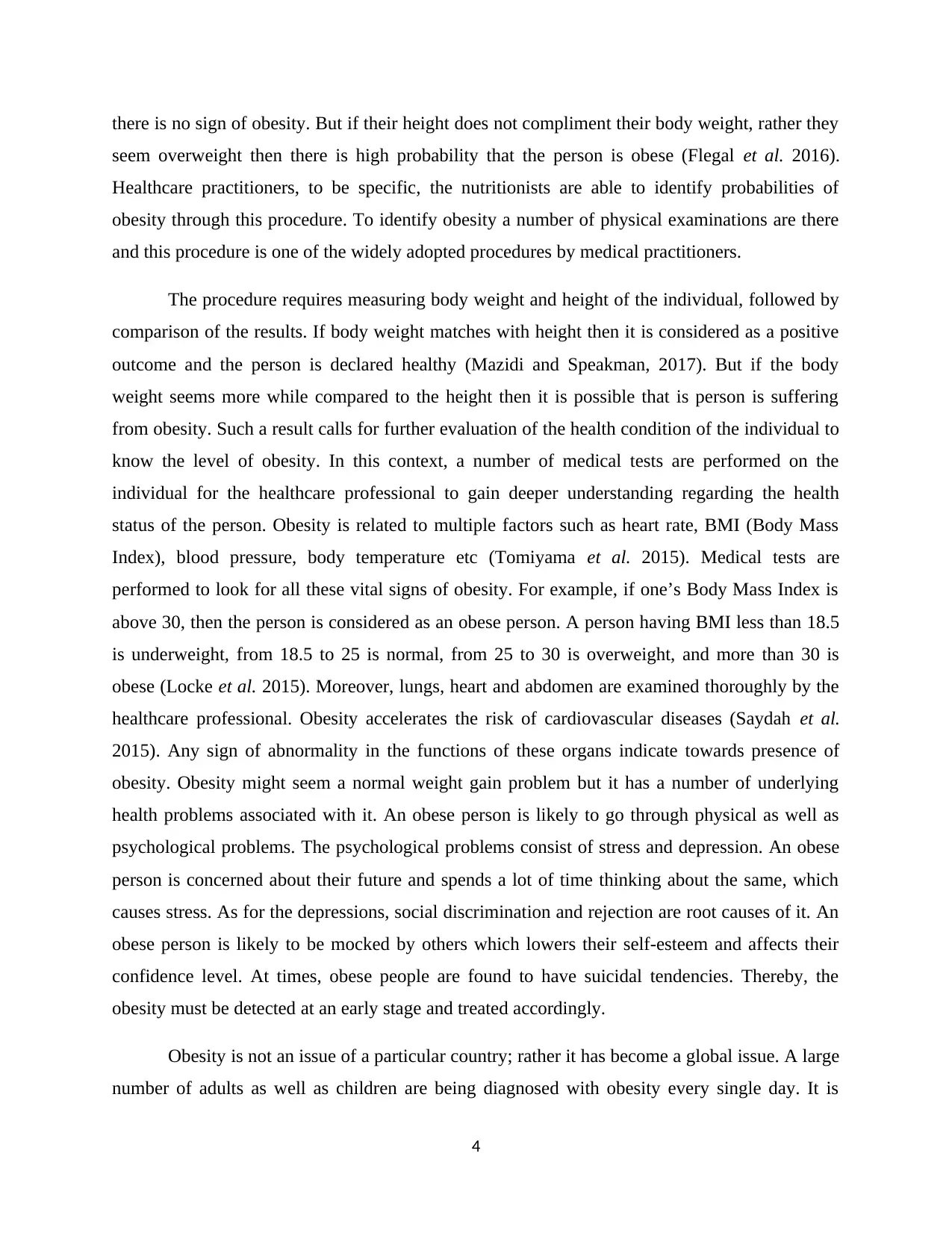
there is no sign of obesity. But if their height does not compliment their body weight, rather they
seem overweight then there is high probability that the person is obese (Flegal et al. 2016).
Healthcare practitioners, to be specific, the nutritionists are able to identify probabilities of
obesity through this procedure. To identify obesity a number of physical examinations are there
and this procedure is one of the widely adopted procedures by medical practitioners.
The procedure requires measuring body weight and height of the individual, followed by
comparison of the results. If body weight matches with height then it is considered as a positive
outcome and the person is declared healthy (Mazidi and Speakman, 2017). But if the body
weight seems more while compared to the height then it is possible that is person is suffering
from obesity. Such a result calls for further evaluation of the health condition of the individual to
know the level of obesity. In this context, a number of medical tests are performed on the
individual for the healthcare professional to gain deeper understanding regarding the health
status of the person. Obesity is related to multiple factors such as heart rate, BMI (Body Mass
Index), blood pressure, body temperature etc (Tomiyama et al. 2015). Medical tests are
performed to look for all these vital signs of obesity. For example, if one’s Body Mass Index is
above 30, then the person is considered as an obese person. A person having BMI less than 18.5
is underweight, from 18.5 to 25 is normal, from 25 to 30 is overweight, and more than 30 is
obese (Locke et al. 2015). Moreover, lungs, heart and abdomen are examined thoroughly by the
healthcare professional. Obesity accelerates the risk of cardiovascular diseases (Saydah et al.
2015). Any sign of abnormality in the functions of these organs indicate towards presence of
obesity. Obesity might seem a normal weight gain problem but it has a number of underlying
health problems associated with it. An obese person is likely to go through physical as well as
psychological problems. The psychological problems consist of stress and depression. An obese
person is concerned about their future and spends a lot of time thinking about the same, which
causes stress. As for the depressions, social discrimination and rejection are root causes of it. An
obese person is likely to be mocked by others which lowers their self-esteem and affects their
confidence level. At times, obese people are found to have suicidal tendencies. Thereby, the
obesity must be detected at an early stage and treated accordingly.
Obesity is not an issue of a particular country; rather it has become a global issue. A large
number of adults as well as children are being diagnosed with obesity every single day. It is
4
seem overweight then there is high probability that the person is obese (Flegal et al. 2016).
Healthcare practitioners, to be specific, the nutritionists are able to identify probabilities of
obesity through this procedure. To identify obesity a number of physical examinations are there
and this procedure is one of the widely adopted procedures by medical practitioners.
The procedure requires measuring body weight and height of the individual, followed by
comparison of the results. If body weight matches with height then it is considered as a positive
outcome and the person is declared healthy (Mazidi and Speakman, 2017). But if the body
weight seems more while compared to the height then it is possible that is person is suffering
from obesity. Such a result calls for further evaluation of the health condition of the individual to
know the level of obesity. In this context, a number of medical tests are performed on the
individual for the healthcare professional to gain deeper understanding regarding the health
status of the person. Obesity is related to multiple factors such as heart rate, BMI (Body Mass
Index), blood pressure, body temperature etc (Tomiyama et al. 2015). Medical tests are
performed to look for all these vital signs of obesity. For example, if one’s Body Mass Index is
above 30, then the person is considered as an obese person. A person having BMI less than 18.5
is underweight, from 18.5 to 25 is normal, from 25 to 30 is overweight, and more than 30 is
obese (Locke et al. 2015). Moreover, lungs, heart and abdomen are examined thoroughly by the
healthcare professional. Obesity accelerates the risk of cardiovascular diseases (Saydah et al.
2015). Any sign of abnormality in the functions of these organs indicate towards presence of
obesity. Obesity might seem a normal weight gain problem but it has a number of underlying
health problems associated with it. An obese person is likely to go through physical as well as
psychological problems. The psychological problems consist of stress and depression. An obese
person is concerned about their future and spends a lot of time thinking about the same, which
causes stress. As for the depressions, social discrimination and rejection are root causes of it. An
obese person is likely to be mocked by others which lowers their self-esteem and affects their
confidence level. At times, obese people are found to have suicidal tendencies. Thereby, the
obesity must be detected at an early stage and treated accordingly.
Obesity is not an issue of a particular country; rather it has become a global issue. A large
number of adults as well as children are being diagnosed with obesity every single day. It is
4
Paraphrase This Document
Need a fresh take? Get an instant paraphrase of this document with our AI Paraphraser
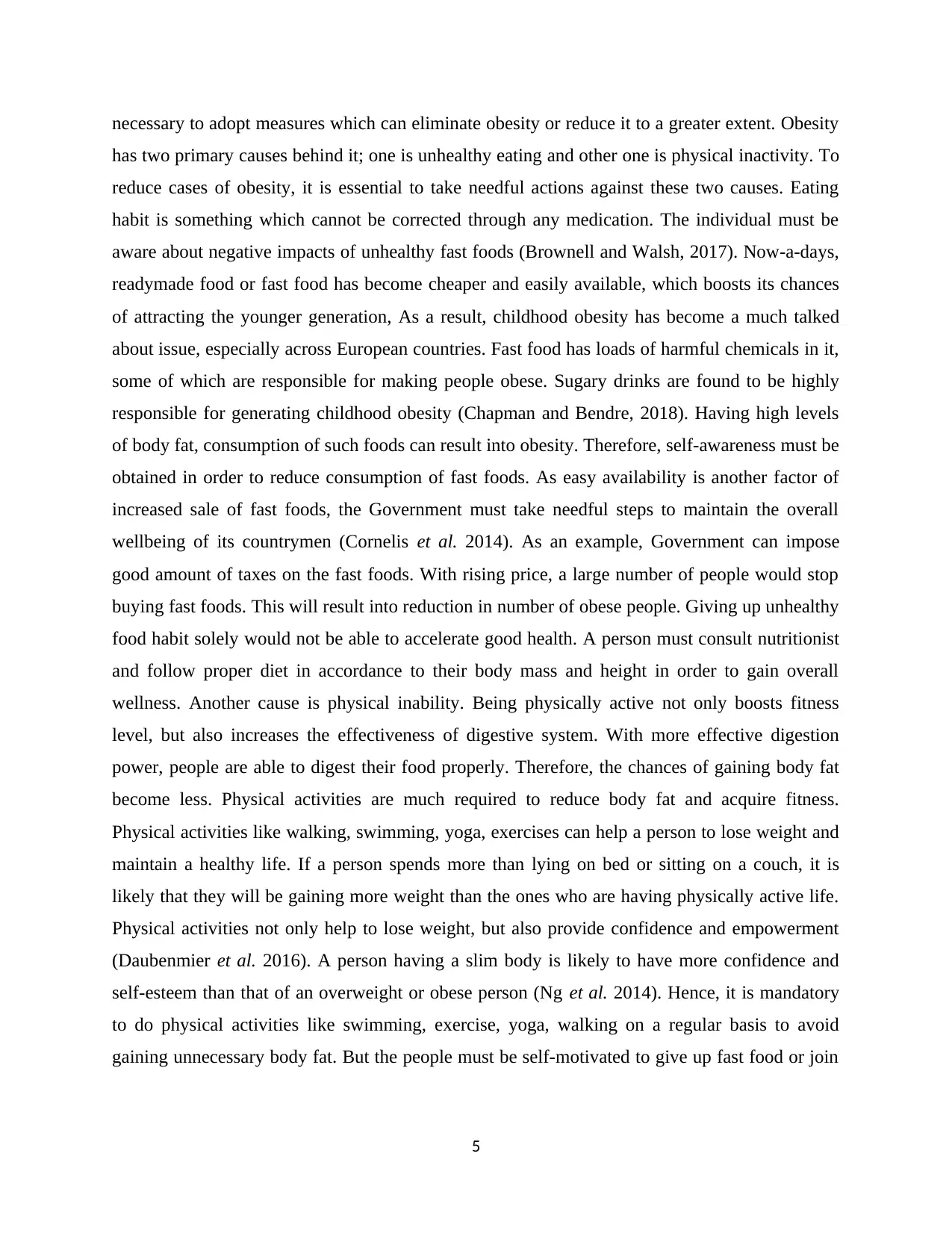
necessary to adopt measures which can eliminate obesity or reduce it to a greater extent. Obesity
has two primary causes behind it; one is unhealthy eating and other one is physical inactivity. To
reduce cases of obesity, it is essential to take needful actions against these two causes. Eating
habit is something which cannot be corrected through any medication. The individual must be
aware about negative impacts of unhealthy fast foods (Brownell and Walsh, 2017). Now-a-days,
readymade food or fast food has become cheaper and easily available, which boosts its chances
of attracting the younger generation, As a result, childhood obesity has become a much talked
about issue, especially across European countries. Fast food has loads of harmful chemicals in it,
some of which are responsible for making people obese. Sugary drinks are found to be highly
responsible for generating childhood obesity (Chapman and Bendre, 2018). Having high levels
of body fat, consumption of such foods can result into obesity. Therefore, self-awareness must be
obtained in order to reduce consumption of fast foods. As easy availability is another factor of
increased sale of fast foods, the Government must take needful steps to maintain the overall
wellbeing of its countrymen (Cornelis et al. 2014). As an example, Government can impose
good amount of taxes on the fast foods. With rising price, a large number of people would stop
buying fast foods. This will result into reduction in number of obese people. Giving up unhealthy
food habit solely would not be able to accelerate good health. A person must consult nutritionist
and follow proper diet in accordance to their body mass and height in order to gain overall
wellness. Another cause is physical inability. Being physically active not only boosts fitness
level, but also increases the effectiveness of digestive system. With more effective digestion
power, people are able to digest their food properly. Therefore, the chances of gaining body fat
become less. Physical activities are much required to reduce body fat and acquire fitness.
Physical activities like walking, swimming, yoga, exercises can help a person to lose weight and
maintain a healthy life. If a person spends more than lying on bed or sitting on a couch, it is
likely that they will be gaining more weight than the ones who are having physically active life.
Physical activities not only help to lose weight, but also provide confidence and empowerment
(Daubenmier et al. 2016). A person having a slim body is likely to have more confidence and
self-esteem than that of an overweight or obese person (Ng et al. 2014). Hence, it is mandatory
to do physical activities like swimming, exercise, yoga, walking on a regular basis to avoid
gaining unnecessary body fat. But the people must be self-motivated to give up fast food or join
5
has two primary causes behind it; one is unhealthy eating and other one is physical inactivity. To
reduce cases of obesity, it is essential to take needful actions against these two causes. Eating
habit is something which cannot be corrected through any medication. The individual must be
aware about negative impacts of unhealthy fast foods (Brownell and Walsh, 2017). Now-a-days,
readymade food or fast food has become cheaper and easily available, which boosts its chances
of attracting the younger generation, As a result, childhood obesity has become a much talked
about issue, especially across European countries. Fast food has loads of harmful chemicals in it,
some of which are responsible for making people obese. Sugary drinks are found to be highly
responsible for generating childhood obesity (Chapman and Bendre, 2018). Having high levels
of body fat, consumption of such foods can result into obesity. Therefore, self-awareness must be
obtained in order to reduce consumption of fast foods. As easy availability is another factor of
increased sale of fast foods, the Government must take needful steps to maintain the overall
wellbeing of its countrymen (Cornelis et al. 2014). As an example, Government can impose
good amount of taxes on the fast foods. With rising price, a large number of people would stop
buying fast foods. This will result into reduction in number of obese people. Giving up unhealthy
food habit solely would not be able to accelerate good health. A person must consult nutritionist
and follow proper diet in accordance to their body mass and height in order to gain overall
wellness. Another cause is physical inability. Being physically active not only boosts fitness
level, but also increases the effectiveness of digestive system. With more effective digestion
power, people are able to digest their food properly. Therefore, the chances of gaining body fat
become less. Physical activities are much required to reduce body fat and acquire fitness.
Physical activities like walking, swimming, yoga, exercises can help a person to lose weight and
maintain a healthy life. If a person spends more than lying on bed or sitting on a couch, it is
likely that they will be gaining more weight than the ones who are having physically active life.
Physical activities not only help to lose weight, but also provide confidence and empowerment
(Daubenmier et al. 2016). A person having a slim body is likely to have more confidence and
self-esteem than that of an overweight or obese person (Ng et al. 2014). Hence, it is mandatory
to do physical activities like swimming, exercise, yoga, walking on a regular basis to avoid
gaining unnecessary body fat. But the people must be self-motivated to give up fast food or join
5
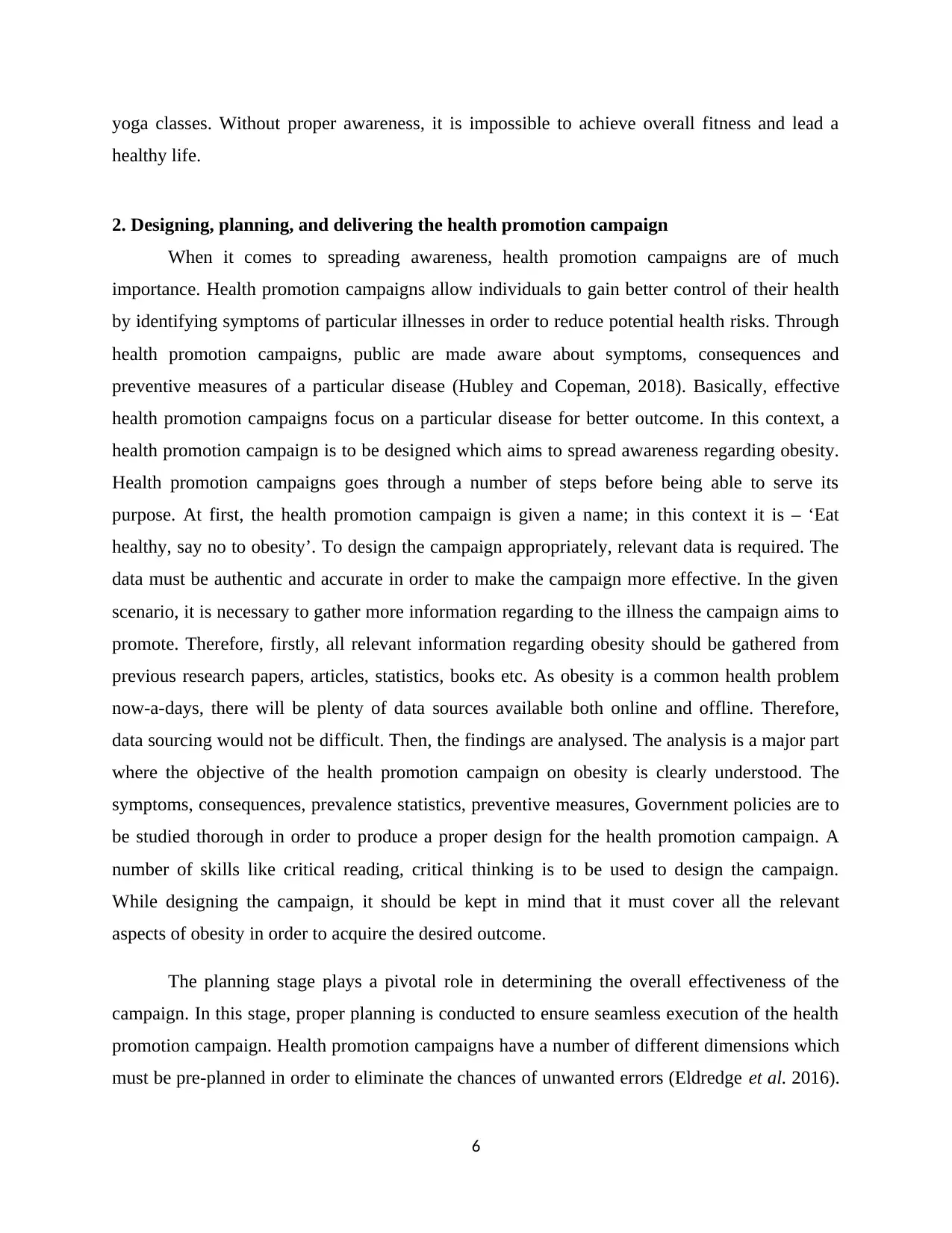
yoga classes. Without proper awareness, it is impossible to achieve overall fitness and lead a
healthy life.
2. Designing, planning, and delivering the health promotion campaign
When it comes to spreading awareness, health promotion campaigns are of much
importance. Health promotion campaigns allow individuals to gain better control of their health
by identifying symptoms of particular illnesses in order to reduce potential health risks. Through
health promotion campaigns, public are made aware about symptoms, consequences and
preventive measures of a particular disease (Hubley and Copeman, 2018). Basically, effective
health promotion campaigns focus on a particular disease for better outcome. In this context, a
health promotion campaign is to be designed which aims to spread awareness regarding obesity.
Health promotion campaigns goes through a number of steps before being able to serve its
purpose. At first, the health promotion campaign is given a name; in this context it is – ‘Eat
healthy, say no to obesity’. To design the campaign appropriately, relevant data is required. The
data must be authentic and accurate in order to make the campaign more effective. In the given
scenario, it is necessary to gather more information regarding to the illness the campaign aims to
promote. Therefore, firstly, all relevant information regarding obesity should be gathered from
previous research papers, articles, statistics, books etc. As obesity is a common health problem
now-a-days, there will be plenty of data sources available both online and offline. Therefore,
data sourcing would not be difficult. Then, the findings are analysed. The analysis is a major part
where the objective of the health promotion campaign on obesity is clearly understood. The
symptoms, consequences, prevalence statistics, preventive measures, Government policies are to
be studied thorough in order to produce a proper design for the health promotion campaign. A
number of skills like critical reading, critical thinking is to be used to design the campaign.
While designing the campaign, it should be kept in mind that it must cover all the relevant
aspects of obesity in order to acquire the desired outcome.
The planning stage plays a pivotal role in determining the overall effectiveness of the
campaign. In this stage, proper planning is conducted to ensure seamless execution of the health
promotion campaign. Health promotion campaigns have a number of different dimensions which
must be pre-planned in order to eliminate the chances of unwanted errors (Eldredge et al. 2016).
6
healthy life.
2. Designing, planning, and delivering the health promotion campaign
When it comes to spreading awareness, health promotion campaigns are of much
importance. Health promotion campaigns allow individuals to gain better control of their health
by identifying symptoms of particular illnesses in order to reduce potential health risks. Through
health promotion campaigns, public are made aware about symptoms, consequences and
preventive measures of a particular disease (Hubley and Copeman, 2018). Basically, effective
health promotion campaigns focus on a particular disease for better outcome. In this context, a
health promotion campaign is to be designed which aims to spread awareness regarding obesity.
Health promotion campaigns goes through a number of steps before being able to serve its
purpose. At first, the health promotion campaign is given a name; in this context it is – ‘Eat
healthy, say no to obesity’. To design the campaign appropriately, relevant data is required. The
data must be authentic and accurate in order to make the campaign more effective. In the given
scenario, it is necessary to gather more information regarding to the illness the campaign aims to
promote. Therefore, firstly, all relevant information regarding obesity should be gathered from
previous research papers, articles, statistics, books etc. As obesity is a common health problem
now-a-days, there will be plenty of data sources available both online and offline. Therefore,
data sourcing would not be difficult. Then, the findings are analysed. The analysis is a major part
where the objective of the health promotion campaign on obesity is clearly understood. The
symptoms, consequences, prevalence statistics, preventive measures, Government policies are to
be studied thorough in order to produce a proper design for the health promotion campaign. A
number of skills like critical reading, critical thinking is to be used to design the campaign.
While designing the campaign, it should be kept in mind that it must cover all the relevant
aspects of obesity in order to acquire the desired outcome.
The planning stage plays a pivotal role in determining the overall effectiveness of the
campaign. In this stage, proper planning is conducted to ensure seamless execution of the health
promotion campaign. Health promotion campaigns have a number of different dimensions which
must be pre-planned in order to eliminate the chances of unwanted errors (Eldredge et al. 2016).
6
⊘ This is a preview!⊘
Do you want full access?
Subscribe today to unlock all pages.

Trusted by 1+ million students worldwide
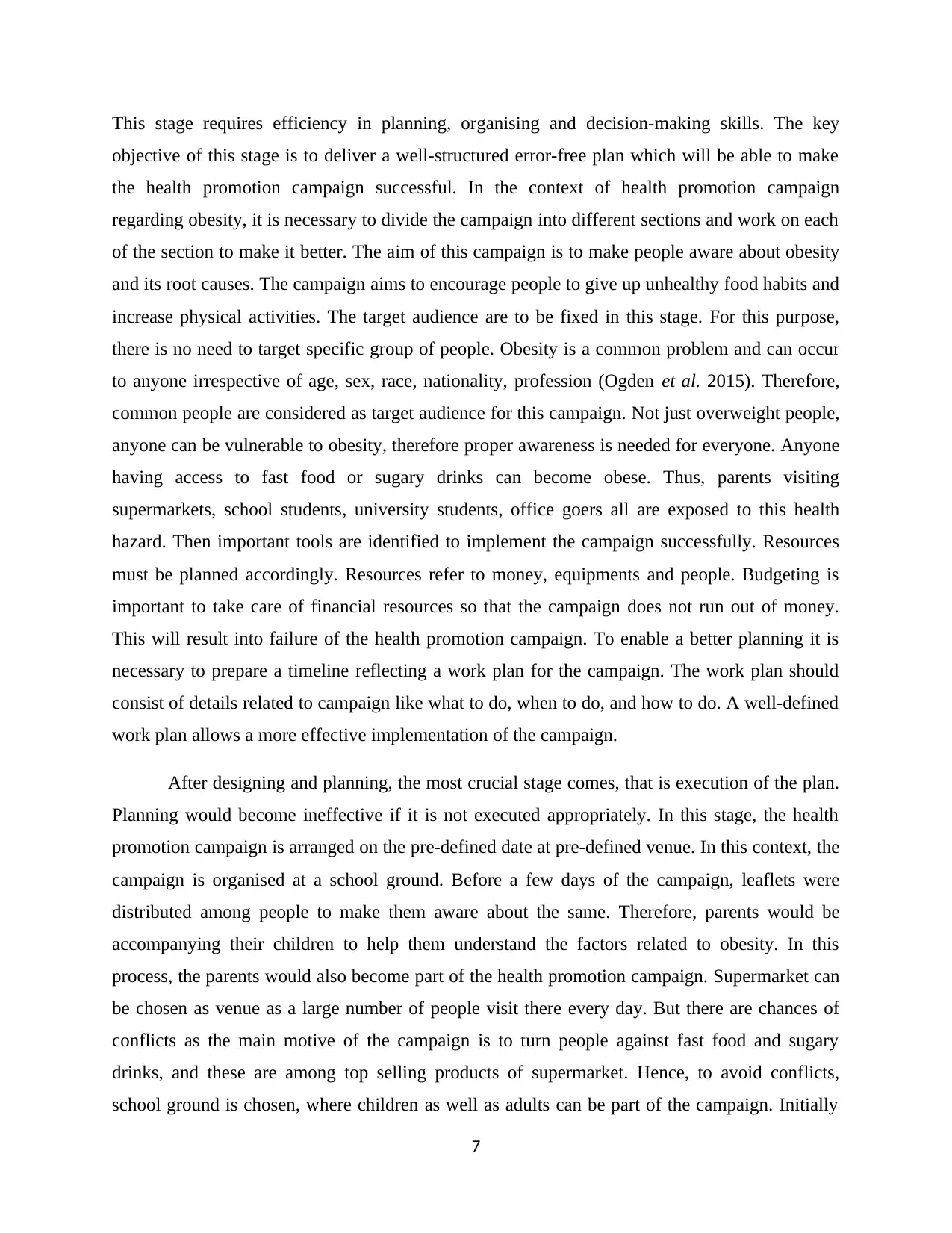
This stage requires efficiency in planning, organising and decision-making skills. The key
objective of this stage is to deliver a well-structured error-free plan which will be able to make
the health promotion campaign successful. In the context of health promotion campaign
regarding obesity, it is necessary to divide the campaign into different sections and work on each
of the section to make it better. The aim of this campaign is to make people aware about obesity
and its root causes. The campaign aims to encourage people to give up unhealthy food habits and
increase physical activities. The target audience are to be fixed in this stage. For this purpose,
there is no need to target specific group of people. Obesity is a common problem and can occur
to anyone irrespective of age, sex, race, nationality, profession (Ogden et al. 2015). Therefore,
common people are considered as target audience for this campaign. Not just overweight people,
anyone can be vulnerable to obesity, therefore proper awareness is needed for everyone. Anyone
having access to fast food or sugary drinks can become obese. Thus, parents visiting
supermarkets, school students, university students, office goers all are exposed to this health
hazard. Then important tools are identified to implement the campaign successfully. Resources
must be planned accordingly. Resources refer to money, equipments and people. Budgeting is
important to take care of financial resources so that the campaign does not run out of money.
This will result into failure of the health promotion campaign. To enable a better planning it is
necessary to prepare a timeline reflecting a work plan for the campaign. The work plan should
consist of details related to campaign like what to do, when to do, and how to do. A well-defined
work plan allows a more effective implementation of the campaign.
After designing and planning, the most crucial stage comes, that is execution of the plan.
Planning would become ineffective if it is not executed appropriately. In this stage, the health
promotion campaign is arranged on the pre-defined date at pre-defined venue. In this context, the
campaign is organised at a school ground. Before a few days of the campaign, leaflets were
distributed among people to make them aware about the same. Therefore, parents would be
accompanying their children to help them understand the factors related to obesity. In this
process, the parents would also become part of the health promotion campaign. Supermarket can
be chosen as venue as a large number of people visit there every day. But there are chances of
conflicts as the main motive of the campaign is to turn people against fast food and sugary
drinks, and these are among top selling products of supermarket. Hence, to avoid conflicts,
school ground is chosen, where children as well as adults can be part of the campaign. Initially
7
objective of this stage is to deliver a well-structured error-free plan which will be able to make
the health promotion campaign successful. In the context of health promotion campaign
regarding obesity, it is necessary to divide the campaign into different sections and work on each
of the section to make it better. The aim of this campaign is to make people aware about obesity
and its root causes. The campaign aims to encourage people to give up unhealthy food habits and
increase physical activities. The target audience are to be fixed in this stage. For this purpose,
there is no need to target specific group of people. Obesity is a common problem and can occur
to anyone irrespective of age, sex, race, nationality, profession (Ogden et al. 2015). Therefore,
common people are considered as target audience for this campaign. Not just overweight people,
anyone can be vulnerable to obesity, therefore proper awareness is needed for everyone. Anyone
having access to fast food or sugary drinks can become obese. Thus, parents visiting
supermarkets, school students, university students, office goers all are exposed to this health
hazard. Then important tools are identified to implement the campaign successfully. Resources
must be planned accordingly. Resources refer to money, equipments and people. Budgeting is
important to take care of financial resources so that the campaign does not run out of money.
This will result into failure of the health promotion campaign. To enable a better planning it is
necessary to prepare a timeline reflecting a work plan for the campaign. The work plan should
consist of details related to campaign like what to do, when to do, and how to do. A well-defined
work plan allows a more effective implementation of the campaign.
After designing and planning, the most crucial stage comes, that is execution of the plan.
Planning would become ineffective if it is not executed appropriately. In this stage, the health
promotion campaign is arranged on the pre-defined date at pre-defined venue. In this context, the
campaign is organised at a school ground. Before a few days of the campaign, leaflets were
distributed among people to make them aware about the same. Therefore, parents would be
accompanying their children to help them understand the factors related to obesity. In this
process, the parents would also become part of the health promotion campaign. Supermarket can
be chosen as venue as a large number of people visit there every day. But there are chances of
conflicts as the main motive of the campaign is to turn people against fast food and sugary
drinks, and these are among top selling products of supermarket. Hence, to avoid conflicts,
school ground is chosen, where children as well as adults can be part of the campaign. Initially
7
Paraphrase This Document
Need a fresh take? Get an instant paraphrase of this document with our AI Paraphraser
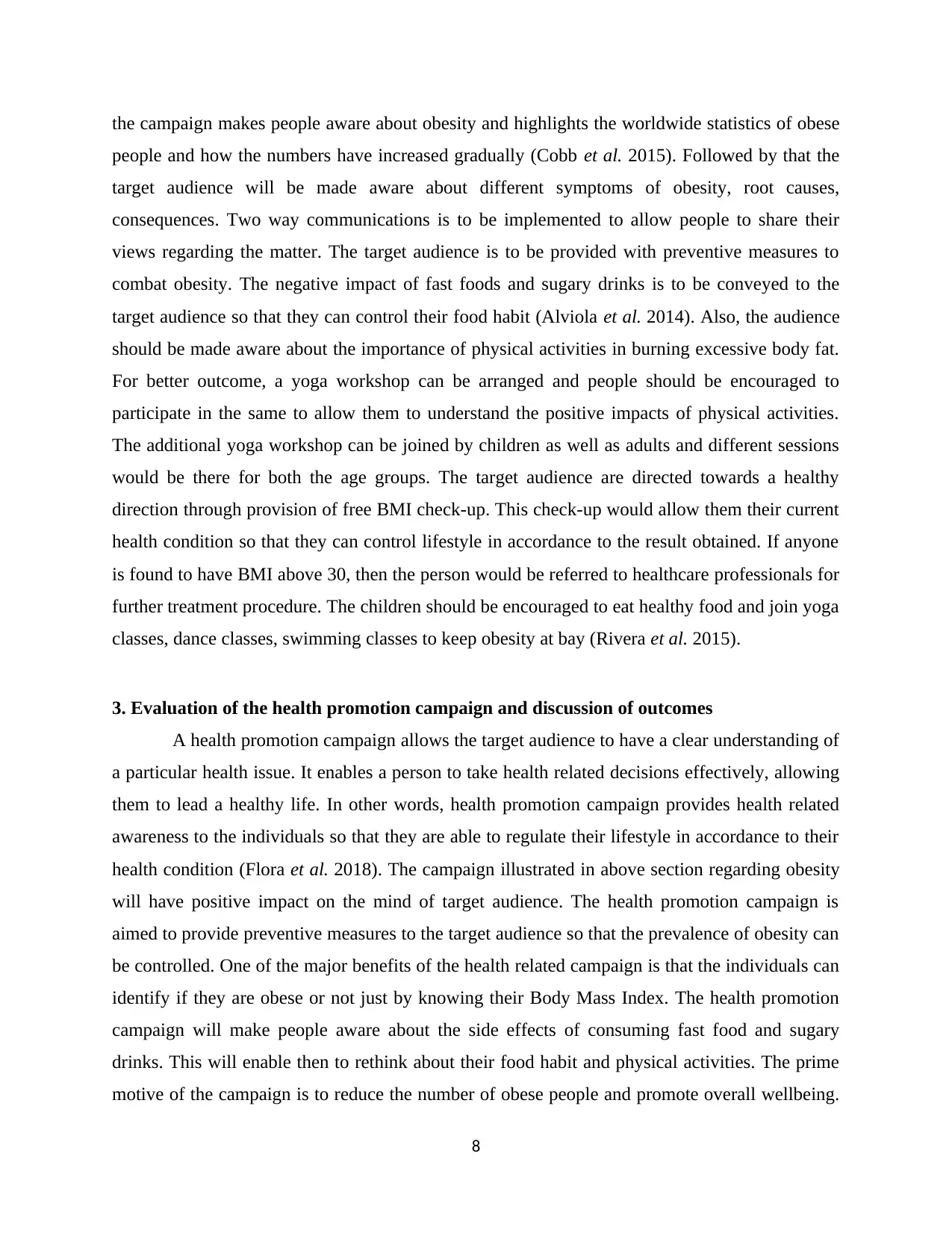
the campaign makes people aware about obesity and highlights the worldwide statistics of obese
people and how the numbers have increased gradually (Cobb et al. 2015). Followed by that the
target audience will be made aware about different symptoms of obesity, root causes,
consequences. Two way communications is to be implemented to allow people to share their
views regarding the matter. The target audience is to be provided with preventive measures to
combat obesity. The negative impact of fast foods and sugary drinks is to be conveyed to the
target audience so that they can control their food habit (Alviola et al. 2014). Also, the audience
should be made aware about the importance of physical activities in burning excessive body fat.
For better outcome, a yoga workshop can be arranged and people should be encouraged to
participate in the same to allow them to understand the positive impacts of physical activities.
The additional yoga workshop can be joined by children as well as adults and different sessions
would be there for both the age groups. The target audience are directed towards a healthy
direction through provision of free BMI check-up. This check-up would allow them their current
health condition so that they can control lifestyle in accordance to the result obtained. If anyone
is found to have BMI above 30, then the person would be referred to healthcare professionals for
further treatment procedure. The children should be encouraged to eat healthy food and join yoga
classes, dance classes, swimming classes to keep obesity at bay (Rivera et al. 2015).
3. Evaluation of the health promotion campaign and discussion of outcomes
A health promotion campaign allows the target audience to have a clear understanding of
a particular health issue. It enables a person to take health related decisions effectively, allowing
them to lead a healthy life. In other words, health promotion campaign provides health related
awareness to the individuals so that they are able to regulate their lifestyle in accordance to their
health condition (Flora et al. 2018). The campaign illustrated in above section regarding obesity
will have positive impact on the mind of target audience. The health promotion campaign is
aimed to provide preventive measures to the target audience so that the prevalence of obesity can
be controlled. One of the major benefits of the health related campaign is that the individuals can
identify if they are obese or not just by knowing their Body Mass Index. The health promotion
campaign will make people aware about the side effects of consuming fast food and sugary
drinks. This will enable then to rethink about their food habit and physical activities. The prime
motive of the campaign is to reduce the number of obese people and promote overall wellbeing.
8
people and how the numbers have increased gradually (Cobb et al. 2015). Followed by that the
target audience will be made aware about different symptoms of obesity, root causes,
consequences. Two way communications is to be implemented to allow people to share their
views regarding the matter. The target audience is to be provided with preventive measures to
combat obesity. The negative impact of fast foods and sugary drinks is to be conveyed to the
target audience so that they can control their food habit (Alviola et al. 2014). Also, the audience
should be made aware about the importance of physical activities in burning excessive body fat.
For better outcome, a yoga workshop can be arranged and people should be encouraged to
participate in the same to allow them to understand the positive impacts of physical activities.
The additional yoga workshop can be joined by children as well as adults and different sessions
would be there for both the age groups. The target audience are directed towards a healthy
direction through provision of free BMI check-up. This check-up would allow them their current
health condition so that they can control lifestyle in accordance to the result obtained. If anyone
is found to have BMI above 30, then the person would be referred to healthcare professionals for
further treatment procedure. The children should be encouraged to eat healthy food and join yoga
classes, dance classes, swimming classes to keep obesity at bay (Rivera et al. 2015).
3. Evaluation of the health promotion campaign and discussion of outcomes
A health promotion campaign allows the target audience to have a clear understanding of
a particular health issue. It enables a person to take health related decisions effectively, allowing
them to lead a healthy life. In other words, health promotion campaign provides health related
awareness to the individuals so that they are able to regulate their lifestyle in accordance to their
health condition (Flora et al. 2018). The campaign illustrated in above section regarding obesity
will have positive impact on the mind of target audience. The health promotion campaign is
aimed to provide preventive measures to the target audience so that the prevalence of obesity can
be controlled. One of the major benefits of the health related campaign is that the individuals can
identify if they are obese or not just by knowing their Body Mass Index. The health promotion
campaign will make people aware about the side effects of consuming fast food and sugary
drinks. This will enable then to rethink about their food habit and physical activities. The prime
motive of the campaign is to reduce the number of obese people and promote overall wellbeing.
8
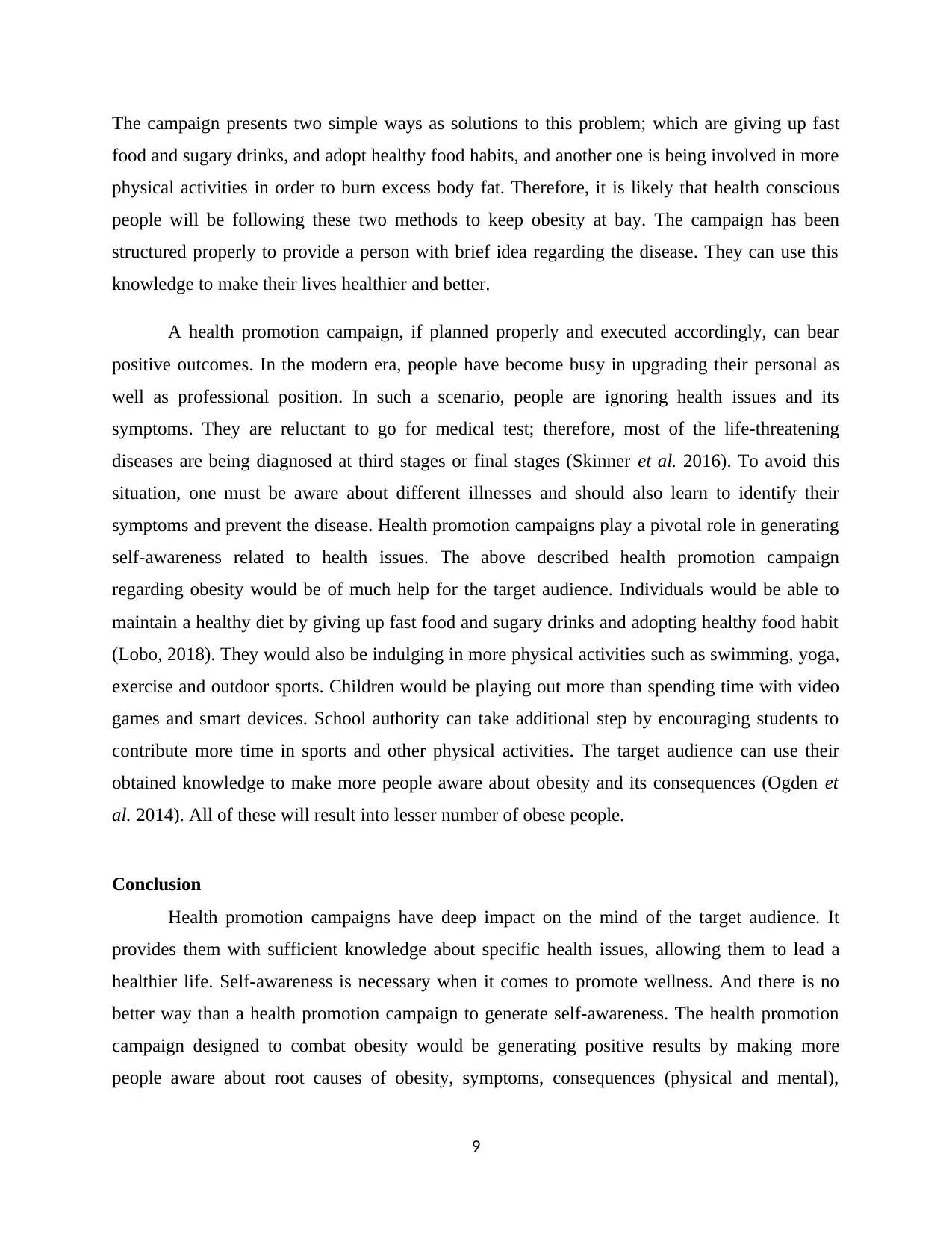
The campaign presents two simple ways as solutions to this problem; which are giving up fast
food and sugary drinks, and adopt healthy food habits, and another one is being involved in more
physical activities in order to burn excess body fat. Therefore, it is likely that health conscious
people will be following these two methods to keep obesity at bay. The campaign has been
structured properly to provide a person with brief idea regarding the disease. They can use this
knowledge to make their lives healthier and better.
A health promotion campaign, if planned properly and executed accordingly, can bear
positive outcomes. In the modern era, people have become busy in upgrading their personal as
well as professional position. In such a scenario, people are ignoring health issues and its
symptoms. They are reluctant to go for medical test; therefore, most of the life-threatening
diseases are being diagnosed at third stages or final stages (Skinner et al. 2016). To avoid this
situation, one must be aware about different illnesses and should also learn to identify their
symptoms and prevent the disease. Health promotion campaigns play a pivotal role in generating
self-awareness related to health issues. The above described health promotion campaign
regarding obesity would be of much help for the target audience. Individuals would be able to
maintain a healthy diet by giving up fast food and sugary drinks and adopting healthy food habit
(Lobo, 2018). They would also be indulging in more physical activities such as swimming, yoga,
exercise and outdoor sports. Children would be playing out more than spending time with video
games and smart devices. School authority can take additional step by encouraging students to
contribute more time in sports and other physical activities. The target audience can use their
obtained knowledge to make more people aware about obesity and its consequences (Ogden et
al. 2014). All of these will result into lesser number of obese people.
Conclusion
Health promotion campaigns have deep impact on the mind of the target audience. It
provides them with sufficient knowledge about specific health issues, allowing them to lead a
healthier life. Self-awareness is necessary when it comes to promote wellness. And there is no
better way than a health promotion campaign to generate self-awareness. The health promotion
campaign designed to combat obesity would be generating positive results by making more
people aware about root causes of obesity, symptoms, consequences (physical and mental),
9
food and sugary drinks, and adopt healthy food habits, and another one is being involved in more
physical activities in order to burn excess body fat. Therefore, it is likely that health conscious
people will be following these two methods to keep obesity at bay. The campaign has been
structured properly to provide a person with brief idea regarding the disease. They can use this
knowledge to make their lives healthier and better.
A health promotion campaign, if planned properly and executed accordingly, can bear
positive outcomes. In the modern era, people have become busy in upgrading their personal as
well as professional position. In such a scenario, people are ignoring health issues and its
symptoms. They are reluctant to go for medical test; therefore, most of the life-threatening
diseases are being diagnosed at third stages or final stages (Skinner et al. 2016). To avoid this
situation, one must be aware about different illnesses and should also learn to identify their
symptoms and prevent the disease. Health promotion campaigns play a pivotal role in generating
self-awareness related to health issues. The above described health promotion campaign
regarding obesity would be of much help for the target audience. Individuals would be able to
maintain a healthy diet by giving up fast food and sugary drinks and adopting healthy food habit
(Lobo, 2018). They would also be indulging in more physical activities such as swimming, yoga,
exercise and outdoor sports. Children would be playing out more than spending time with video
games and smart devices. School authority can take additional step by encouraging students to
contribute more time in sports and other physical activities. The target audience can use their
obtained knowledge to make more people aware about obesity and its consequences (Ogden et
al. 2014). All of these will result into lesser number of obese people.
Conclusion
Health promotion campaigns have deep impact on the mind of the target audience. It
provides them with sufficient knowledge about specific health issues, allowing them to lead a
healthier life. Self-awareness is necessary when it comes to promote wellness. And there is no
better way than a health promotion campaign to generate self-awareness. The health promotion
campaign designed to combat obesity would be generating positive results by making more
people aware about root causes of obesity, symptoms, consequences (physical and mental),
9
⊘ This is a preview!⊘
Do you want full access?
Subscribe today to unlock all pages.

Trusted by 1+ million students worldwide

worldwide statistics and health reports. It will provide them with preventions which upgrade
their health conditions.
10
their health conditions.
10
Paraphrase This Document
Need a fresh take? Get an instant paraphrase of this document with our AI Paraphraser
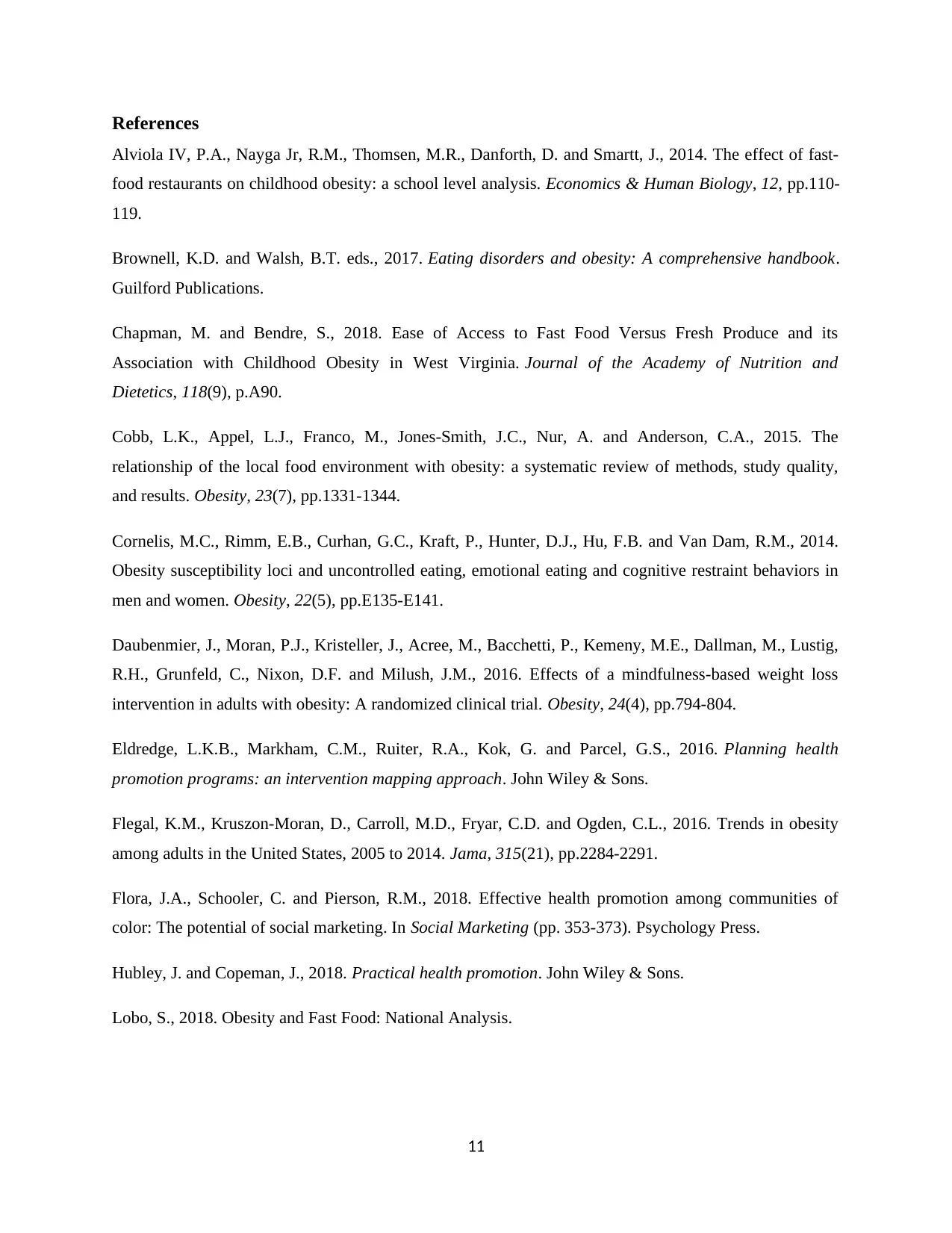
References
Alviola IV, P.A., Nayga Jr, R.M., Thomsen, M.R., Danforth, D. and Smartt, J., 2014. The effect of fast-
food restaurants on childhood obesity: a school level analysis. Economics & Human Biology, 12, pp.110-
119.
Brownell, K.D. and Walsh, B.T. eds., 2017. Eating disorders and obesity: A comprehensive handbook.
Guilford Publications.
Chapman, M. and Bendre, S., 2018. Ease of Access to Fast Food Versus Fresh Produce and its
Association with Childhood Obesity in West Virginia. Journal of the Academy of Nutrition and
Dietetics, 118(9), p.A90.
Cobb, L.K., Appel, L.J., Franco, M., Jones‐Smith, J.C., Nur, A. and Anderson, C.A., 2015. The
relationship of the local food environment with obesity: a systematic review of methods, study quality,
and results. Obesity, 23(7), pp.1331-1344.
Cornelis, M.C., Rimm, E.B., Curhan, G.C., Kraft, P., Hunter, D.J., Hu, F.B. and Van Dam, R.M., 2014.
Obesity susceptibility loci and uncontrolled eating, emotional eating and cognitive restraint behaviors in
men and women. Obesity, 22(5), pp.E135-E141.
Daubenmier, J., Moran, P.J., Kristeller, J., Acree, M., Bacchetti, P., Kemeny, M.E., Dallman, M., Lustig,
R.H., Grunfeld, C., Nixon, D.F. and Milush, J.M., 2016. Effects of a mindfulness‐based weight loss
intervention in adults with obesity: A randomized clinical trial. Obesity, 24(4), pp.794-804.
Eldredge, L.K.B., Markham, C.M., Ruiter, R.A., Kok, G. and Parcel, G.S., 2016. Planning health
promotion programs: an intervention mapping approach. John Wiley & Sons.
Flegal, K.M., Kruszon-Moran, D., Carroll, M.D., Fryar, C.D. and Ogden, C.L., 2016. Trends in obesity
among adults in the United States, 2005 to 2014. Jama, 315(21), pp.2284-2291.
Flora, J.A., Schooler, C. and Pierson, R.M., 2018. Effective health promotion among communities of
color: The potential of social marketing. In Social Marketing (pp. 353-373). Psychology Press.
Hubley, J. and Copeman, J., 2018. Practical health promotion. John Wiley & Sons.
Lobo, S., 2018. Obesity and Fast Food: National Analysis.
11
Alviola IV, P.A., Nayga Jr, R.M., Thomsen, M.R., Danforth, D. and Smartt, J., 2014. The effect of fast-
food restaurants on childhood obesity: a school level analysis. Economics & Human Biology, 12, pp.110-
119.
Brownell, K.D. and Walsh, B.T. eds., 2017. Eating disorders and obesity: A comprehensive handbook.
Guilford Publications.
Chapman, M. and Bendre, S., 2018. Ease of Access to Fast Food Versus Fresh Produce and its
Association with Childhood Obesity in West Virginia. Journal of the Academy of Nutrition and
Dietetics, 118(9), p.A90.
Cobb, L.K., Appel, L.J., Franco, M., Jones‐Smith, J.C., Nur, A. and Anderson, C.A., 2015. The
relationship of the local food environment with obesity: a systematic review of methods, study quality,
and results. Obesity, 23(7), pp.1331-1344.
Cornelis, M.C., Rimm, E.B., Curhan, G.C., Kraft, P., Hunter, D.J., Hu, F.B. and Van Dam, R.M., 2014.
Obesity susceptibility loci and uncontrolled eating, emotional eating and cognitive restraint behaviors in
men and women. Obesity, 22(5), pp.E135-E141.
Daubenmier, J., Moran, P.J., Kristeller, J., Acree, M., Bacchetti, P., Kemeny, M.E., Dallman, M., Lustig,
R.H., Grunfeld, C., Nixon, D.F. and Milush, J.M., 2016. Effects of a mindfulness‐based weight loss
intervention in adults with obesity: A randomized clinical trial. Obesity, 24(4), pp.794-804.
Eldredge, L.K.B., Markham, C.M., Ruiter, R.A., Kok, G. and Parcel, G.S., 2016. Planning health
promotion programs: an intervention mapping approach. John Wiley & Sons.
Flegal, K.M., Kruszon-Moran, D., Carroll, M.D., Fryar, C.D. and Ogden, C.L., 2016. Trends in obesity
among adults in the United States, 2005 to 2014. Jama, 315(21), pp.2284-2291.
Flora, J.A., Schooler, C. and Pierson, R.M., 2018. Effective health promotion among communities of
color: The potential of social marketing. In Social Marketing (pp. 353-373). Psychology Press.
Hubley, J. and Copeman, J., 2018. Practical health promotion. John Wiley & Sons.
Lobo, S., 2018. Obesity and Fast Food: National Analysis.
11
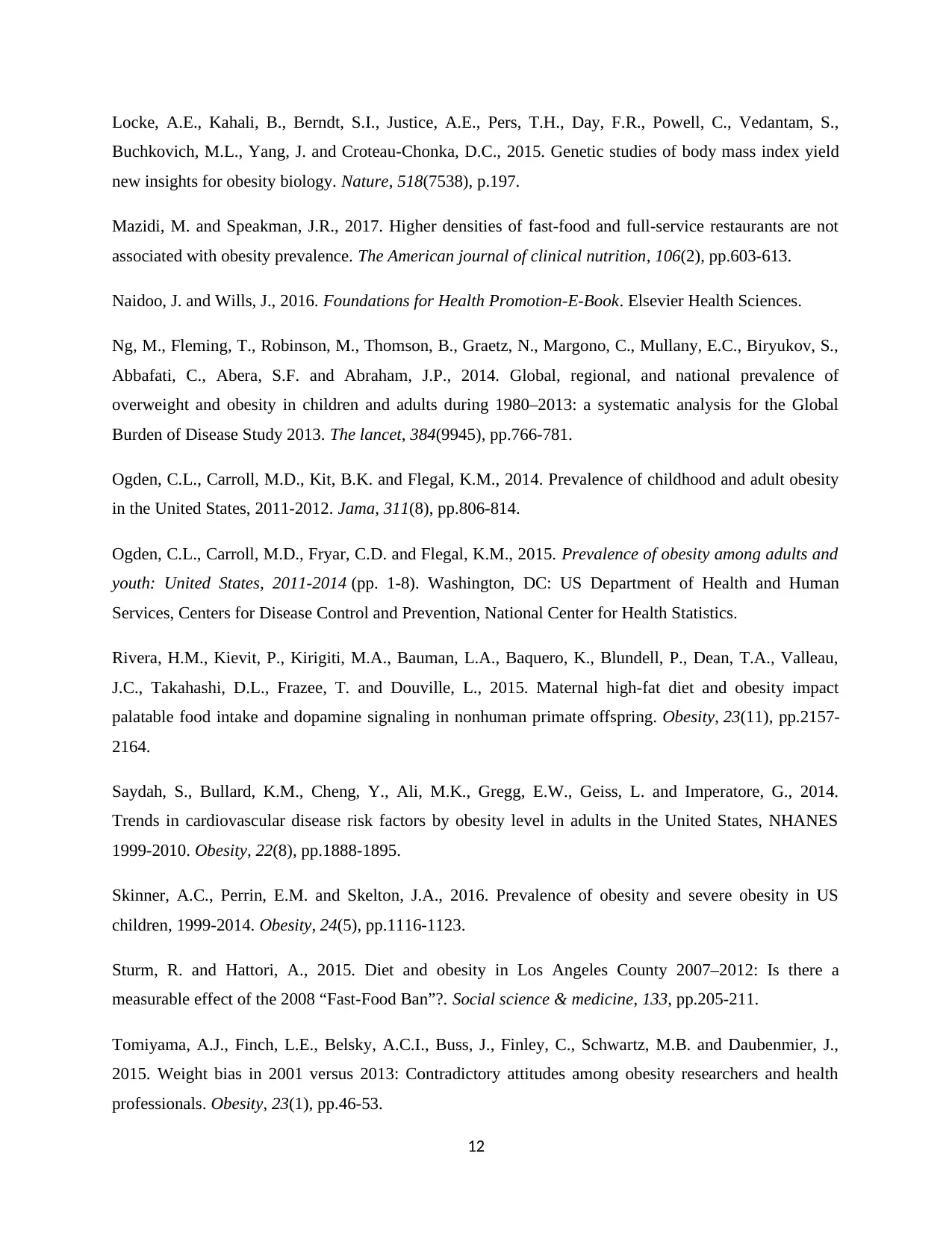
Locke, A.E., Kahali, B., Berndt, S.I., Justice, A.E., Pers, T.H., Day, F.R., Powell, C., Vedantam, S.,
Buchkovich, M.L., Yang, J. and Croteau-Chonka, D.C., 2015. Genetic studies of body mass index yield
new insights for obesity biology. Nature, 518(7538), p.197.
Mazidi, M. and Speakman, J.R., 2017. Higher densities of fast-food and full-service restaurants are not
associated with obesity prevalence. The American journal of clinical nutrition, 106(2), pp.603-613.
Naidoo, J. and Wills, J., 2016. Foundations for Health Promotion-E-Book. Elsevier Health Sciences.
Ng, M., Fleming, T., Robinson, M., Thomson, B., Graetz, N., Margono, C., Mullany, E.C., Biryukov, S.,
Abbafati, C., Abera, S.F. and Abraham, J.P., 2014. Global, regional, and national prevalence of
overweight and obesity in children and adults during 1980–2013: a systematic analysis for the Global
Burden of Disease Study 2013. The lancet, 384(9945), pp.766-781.
Ogden, C.L., Carroll, M.D., Kit, B.K. and Flegal, K.M., 2014. Prevalence of childhood and adult obesity
in the United States, 2011-2012. Jama, 311(8), pp.806-814.
Ogden, C.L., Carroll, M.D., Fryar, C.D. and Flegal, K.M., 2015. Prevalence of obesity among adults and
youth: United States, 2011-2014 (pp. 1-8). Washington, DC: US Department of Health and Human
Services, Centers for Disease Control and Prevention, National Center for Health Statistics.
Rivera, H.M., Kievit, P., Kirigiti, M.A., Bauman, L.A., Baquero, K., Blundell, P., Dean, T.A., Valleau,
J.C., Takahashi, D.L., Frazee, T. and Douville, L., 2015. Maternal high‐fat diet and obesity impact
palatable food intake and dopamine signaling in nonhuman primate offspring. Obesity, 23(11), pp.2157-
2164.
Saydah, S., Bullard, K.M., Cheng, Y., Ali, M.K., Gregg, E.W., Geiss, L. and Imperatore, G., 2014.
Trends in cardiovascular disease risk factors by obesity level in adults in the United States, NHANES
1999‐2010. Obesity, 22(8), pp.1888-1895.
Skinner, A.C., Perrin, E.M. and Skelton, J.A., 2016. Prevalence of obesity and severe obesity in US
children, 1999‐2014. Obesity, 24(5), pp.1116-1123.
Sturm, R. and Hattori, A., 2015. Diet and obesity in Los Angeles County 2007–2012: Is there a
measurable effect of the 2008 “Fast-Food Ban”?. Social science & medicine, 133, pp.205-211.
Tomiyama, A.J., Finch, L.E., Belsky, A.C.I., Buss, J., Finley, C., Schwartz, M.B. and Daubenmier, J.,
2015. Weight bias in 2001 versus 2013: Contradictory attitudes among obesity researchers and health
professionals. Obesity, 23(1), pp.46-53.
12
Buchkovich, M.L., Yang, J. and Croteau-Chonka, D.C., 2015. Genetic studies of body mass index yield
new insights for obesity biology. Nature, 518(7538), p.197.
Mazidi, M. and Speakman, J.R., 2017. Higher densities of fast-food and full-service restaurants are not
associated with obesity prevalence. The American journal of clinical nutrition, 106(2), pp.603-613.
Naidoo, J. and Wills, J., 2016. Foundations for Health Promotion-E-Book. Elsevier Health Sciences.
Ng, M., Fleming, T., Robinson, M., Thomson, B., Graetz, N., Margono, C., Mullany, E.C., Biryukov, S.,
Abbafati, C., Abera, S.F. and Abraham, J.P., 2014. Global, regional, and national prevalence of
overweight and obesity in children and adults during 1980–2013: a systematic analysis for the Global
Burden of Disease Study 2013. The lancet, 384(9945), pp.766-781.
Ogden, C.L., Carroll, M.D., Kit, B.K. and Flegal, K.M., 2014. Prevalence of childhood and adult obesity
in the United States, 2011-2012. Jama, 311(8), pp.806-814.
Ogden, C.L., Carroll, M.D., Fryar, C.D. and Flegal, K.M., 2015. Prevalence of obesity among adults and
youth: United States, 2011-2014 (pp. 1-8). Washington, DC: US Department of Health and Human
Services, Centers for Disease Control and Prevention, National Center for Health Statistics.
Rivera, H.M., Kievit, P., Kirigiti, M.A., Bauman, L.A., Baquero, K., Blundell, P., Dean, T.A., Valleau,
J.C., Takahashi, D.L., Frazee, T. and Douville, L., 2015. Maternal high‐fat diet and obesity impact
palatable food intake and dopamine signaling in nonhuman primate offspring. Obesity, 23(11), pp.2157-
2164.
Saydah, S., Bullard, K.M., Cheng, Y., Ali, M.K., Gregg, E.W., Geiss, L. and Imperatore, G., 2014.
Trends in cardiovascular disease risk factors by obesity level in adults in the United States, NHANES
1999‐2010. Obesity, 22(8), pp.1888-1895.
Skinner, A.C., Perrin, E.M. and Skelton, J.A., 2016. Prevalence of obesity and severe obesity in US
children, 1999‐2014. Obesity, 24(5), pp.1116-1123.
Sturm, R. and Hattori, A., 2015. Diet and obesity in Los Angeles County 2007–2012: Is there a
measurable effect of the 2008 “Fast-Food Ban”?. Social science & medicine, 133, pp.205-211.
Tomiyama, A.J., Finch, L.E., Belsky, A.C.I., Buss, J., Finley, C., Schwartz, M.B. and Daubenmier, J.,
2015. Weight bias in 2001 versus 2013: Contradictory attitudes among obesity researchers and health
professionals. Obesity, 23(1), pp.46-53.
12
⊘ This is a preview!⊘
Do you want full access?
Subscribe today to unlock all pages.

Trusted by 1+ million students worldwide
1 out of 12
Related Documents
Your All-in-One AI-Powered Toolkit for Academic Success.
+13062052269
info@desklib.com
Available 24*7 on WhatsApp / Email
![[object Object]](/_next/static/media/star-bottom.7253800d.svg)
Unlock your academic potential
Copyright © 2020–2025 A2Z Services. All Rights Reserved. Developed and managed by ZUCOL.





